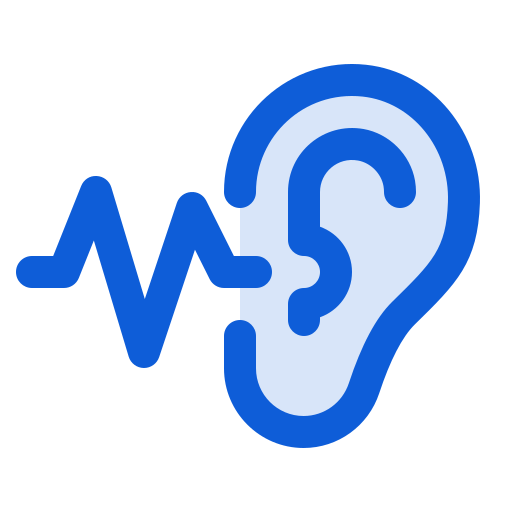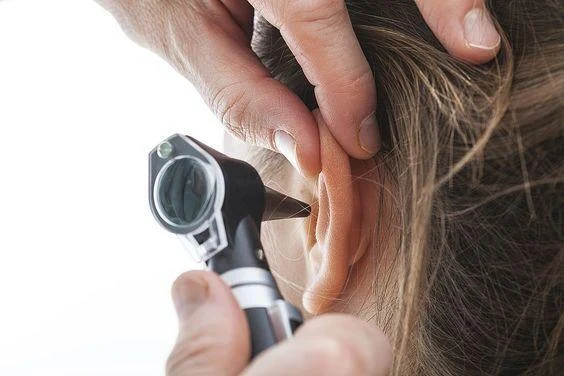A hearing test is very crucial for those who are facing the problem of hearing because it can improve your communication and quality of life. Hearing is an essential part of our body. Regular Hearing Tests easily detect any issue earlier and ensure timely intervention. At Meenakshi Speech and Hearing Clinic, we provide a variety of hearing tests to fulfill our patient’s needs and follow the process of early diagnosis and effective management of hearing loss. We are also dedicated to helping you maintain your optimal hearing health. In this blog, we can explore the various types of hearing tests we offer, explain the procedures, and highlight the importance of audiometric testing.
Types of Hearing Tests
-
Pure-TPure-tonometry
It is the most common hearing test. It is used to assess an individual’s hearing sensitivity and measures the faintest tones a person can hear at different frequencies from low to high pitches. The procedure of this test is:
- The patient sits in the soundproof room.
- Providing to wear a headphone and insert the earphone, which is connected to an audiometer.
- The audiologist is there to measure the series of tones at various frequencies and volumes.
- The patient indicates when they hear properly by raising their hands or pushing the bottom.
- The result is plotted on an audiogram, showing the hearing threshold level for each frequency.
-
Speech Audiometry
Speech audiometry evaluates the person’s ability to hear and understand the speech. This test is similar to pure-tone audiometry and provides a more comprehensive assessment of hearing. The procedure of this test is:
- To provide the headphones to the patient for listening to the recorded or live speech.
- The patient is to repeat the words or sentences after the audiologist.
- This test measures the speech reception threshold (SRT) and speech discrimination score (SDS).
- SRT indicates the lowest volume of speech, which can be understood, while SDS helps to clarify speech perception.
-
Tympanometry
This test examines the middle ear’s function, specifically the movements of the eardrums (tympanic membrane) in response to changes in air pressure and the conduction bones. The procedure of this test is:
- A probe is placed in the ear canal to change the variations in air pressure.
- This device measures the eardrum’s response to these pressure changes.
- Tympanometry helps to detect conditions such as fluid in the middle ear, eardrum perforation, and Eustachian tube dysfunction.
-
Otoacoustic Emissions (OAEs)
Otoacoustic emissions are sounds generated by the inner ear’s (cochlea) response to an auditory stimulus. OAEs are testing the function of the hair cells in the cochlea. The procedure of this test is:
- The small probe is placed in the ear canal.
- The probe radiates sounds and measures the echo response from the cochlea.
- The presence of OAEs indicates normal inner ear function; their absence may suggest hearing loss.
-
Auditory Brainstem Response (ABR)
Auditory Brainstem Response is a test that measures the electrical activity in the auditory nerve and brainstem in response to sound stimuli. It is very useful for testing newborn babies and also for those who cannot actively participate in traditional hearing tests.
- In the patient, the scalp and earlobes are placed in electrodes.
- The patient listens to the sound through the earphones.
- The electrodes record the brain’s response to these sounds.
- ABR helps to diagnose issues with the auditory nerve and pathways.
-
Visual Reinforcement Audiometry (VRA)
VRA is a behavioral or hearing test that is tested on a young child (6 months to 2 years) by observing their response to sound.
- The children sit on their parent’s lap or high chairs.
- Sound is presented through the speaker or earphone.
- When the children responded to the sounds (by moving their heads), they were rewarded with visual stimuli such as light or animated toys.
- VRA helps to determine the child’s hearing threshold and the presence of hearing loss.
Hearing Test Procedures
Hearing Test Procedures are involved in these tests to find your problem and give proper treatment related to your hearing loss issues. It also helps to alleviate any anxiety and ensure an accurate result. Each hearing test has to follow a specific procedure and understand that these procedures help patients feel comfortable during the check-up or their appointments. Here are some steps followed during the hearing test procedure at any clinic:
- Preparation: Avoid the loud music before the test inform the audiologist of your ear infection or related to your hearing loss, and also tell them which medication you are taking.
- Testing Environment: Testing is conducted in a soundproof room to eliminate the background noise and ensure precise measurement.
- Instructions: Our audiologist gives you detailed instructions and procedures. Also, understand that you get the knowledge before starting the test.
Understand the Hearing Test Result
After the test, the audiologist gives you a review and results related to your check-up. Here’s what to expect:
- Audiogram: For pure-tone audiometry, your hearing point at different frequencies is plotted on an audiogram.
- Speech test score: This result is to identify your speech reception point and speech differentiation score by the speech therapy audiologist.
- Middle Ear Function: Tympanometry results will show if there are any problems with your middle ear.
- Inner Ear Function: OAE results will indicate if the tiny hair cells in your inner ear are working properly.
- Auditory Pathways: ABR results give information about the integrity of your auditory nerve and brainstem pathways.
Importance of audiometric testing
Audiometric testing refers to the range of tests used to evaluate hearing ability and identify any hearing impairments. This test measures various aspects related to hearing, including the sensitivity to the different frequencies, speech understanding, and the function of the middle and inner ear. It provides a comprehensive assessment of an individual’s hearing health. I am sharing a point related to “Why audiometric testing is important” for those who are facing a problem with hearing loss:
- Early Detection: It can identify hearing loss in an early stage before symptoms appear. It helps to prevent further deterioration and improve the chances of successful treatment.
- Accurate Diagnosis: It gives full detailed information about the type of hearing loss and his degree. This accuracy is very crucial for developing an effective treatment plan for the individual’s specific needs.
- Monitoring Hearing Health: A regular audiometric test monitors your hearing health over time. It also tracks the change in your hearing ability and helps make adjustments in the treatment plan and hearing aid settings as needed.
- Enhancing Communication: For individuals with hearing loss, the first step is to improve communication through the audiometer test identify. It recognizes the specific frequency and situations where hearing is impaired and allows for targeting strategies to enhance speech understanding and overall communication.
- Preventing Cognitive Decline: Studies have shown that there is a link between untreated hearing loss and cognitive decline, including the increase in dementia. Audiometric tests help reduce the risk and support cognitive health.
- Helping in overall well-being: Hearing loss impacts overall life, including social interaction, work performance, and emotions. Audiometric testing identifies hearing issues and gives proper treatment to maintain their quality of life and be engaged in their daily activities.
Conclusion
Understanding all the different types of hearing tests and their procedures; can help you maintain good hearing health. Whether it’s pure tone audiometry, speech audiometry, tympanometry, otoacoustic emissions, or auditory brainstem response, each test plays an important role in diagnosing and managing hearing loss.
At Meenakshi Speech and Hearing Clinic, we provide a range of hearing tests using diagnosing the latest technology. Our experienced audiologist provides accurate diagnoses and a proper treatment plan that meets your unique needs. We are committed to giving you the best care for your hearing health. It also helps in detecting issues early and allows for timely intervention.
Schedule your appointment with us today and book an appointment through the website or call us. Take the first step towards better hearing health!


